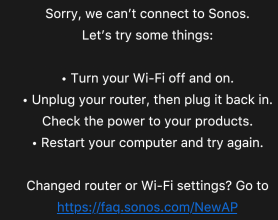Sonos may have a new Bluetooth speaker today, but the Sonos Roam is also donating one of its best features to the company’s existing premium portable model, the Sonos Move. Launched in late 2019, Move paved the way to cutting the cord for Sonos playback, whether around the house or further afield, and instrumental to that was the introduction of Auto Trueplay.
- We would like to show you a description here but the site won’t allow us.
- De Sonos Roam is een kleinere variant van de Sonos Move, de draagbare speaker die anderhalf jaar geleden verscheen. De Roam is een stuk lichter: die weegt nog geen 450 gram en past met afmetingen.
Sonos announced the Move, its first technically portable Bluetooth speaker, back in late 2019 and while it's arguably the best-sounding portable speaker you can buy, its $399 price tag makes it a hard-sell for the masses. It's also quite large; this is a room-to-room portable speaker, not a building-to-building portable speaker.
Regular Trueplay is Sonos’ system for tuning its speakers to work best with the acoustics of the space they’re being used in. With its fixed, mains-powered models, that’s easy: once you’ve set them up in the Sonos app, you walk around for 60-90 seconds waving your phone around, as a whooping tone allows the speaker and app to adjust the EQ settings to suit.
Since Move was designed to be, well, moved, expecting users to go through that every time simply wasn’t feasible. Auto Trueplay works using microphones built into the speaker, which can listen to the reverberations off different surfaces and intelligently – and automatically – adjust playback according to how the space sounds as it’s playing your music. Accelerometers inside triggered that process every time you repositioned Move.
That is, until you switched away from your home WiFi network. Move’s Auto Trueplay only worked when the speaker was in Sonos mode: in Bluetooth mode, it switched off. Roam, however, fixes that, and its version of Auto Trueplay will operate in both WiFi and Bluetooth modes. From today, it’s donating that tech to Move, too.
In a software update released through the Sonos app today, Auto Trueplay gains the ability to adjust the EQ intelligently regardless of which mode you have Move in. As with the system on WiFi, it’ll all happen automatically in the background, though you can turn it off in the Sonos settings.
One caveat is if you’re using Google Assistant. Then, unfortunately, Auto Trueplay on Bluetooth won’t work with Move: Sonos says that’s because, when the Google Assistant is enabled and you switch to Bluetooth, the speaker’s microphone is turned off. Since the tuning system needs to the microphones in order to figure out the acoustic properties of whatever space it’s in, without them it simply can’t deliver those adjustments.
“Sonos works with each of its partners in different ways,” a spokesperson for the company told SlashGear, “and this is the experience it has agreed upon with Google.”
You can install the new version of the Sonos firmware by heading into the app, going to Settings > System > System Updates, and then choosing “Check for Updates” from the menu. You may need to update the Sonos app itself to the latest version in the App Store/Google Play first.


Story Timeline
If you’re a Sonos user looking to bring deeper iPhone, iPad, and Siri integration to your smart speakers, Soro is a new iOS app to accomplish just that. The app is designed to give you additional features for controlling your Sonos speakers with Siri and the Shortcuts app.
The developer explains the idea behind Soro:
Soro extends Siri and the Shortcuts app with 24 new actions to control your Sonos speakers. Create quick actions and workflows to control your speakers with the Shortcuts app using widgets, Siri voice commands, or automations.
In total, Soro includes 24 actions that you can integrate with the Shortcuts app. Those actions include:
- Group/Ungroup
- Set Volume
- Play/Pause/Stop
- Mute/Unmute
- Load music from your “My Sonos” to your speaker or your speakers list
- Load URL
- Set a Sleep Timer
- Set Line-In input
- Set TV input
- Change Repeat/Shuffle
- Adjust Equalizer Settings (Treble/Bass/Loudness/Trueplay)
- Turn Speech Enhancement On/Off
- Turn Night Mode On/Off
- Adjust subwoofer and surround sound settings
Sonos For Macbook
Using these Soro actions in the Shortcuts app, you can create a variety of powerful automations to control your Sonos speakers. For example, you could create a shortcut that sets the volume, groups multiple speakers together, and begins playing your music, all without actually interacting with the Sonos app itself.
Once you create the Sonos automations in the Shortcuts application, you can then use your custom Siri phrase to control your Sonos speakers. You can also run the shortcuts directly from the Shortcuts application, or by adding the Shortcuts widget to your iPhone or iPad’s home screen.
Sonos For Mac Computer
And if you don’t know where to start, Soro includes a variety of example automations that can show you some possible automations. Soro is available on the App Store as a one-time purchase of $5.99, with no other in-app purchases or subscriptions.
Sonos For Macbook Air
FTC: We use income earning auto affiliate links.More.
